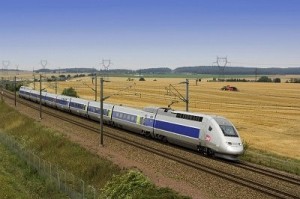Refuting a Bogus Anti-Rail Argument
Anti-rail people attack the notion that the U.S. should follow Europe’s example and make a serious financial investment in inter-city rail service. Their reason? They say it’s apples and oranges because the distances between major urban areas are so much greater in this country.
Oh really? Well, let’s consider four high-speed rail routes in Europe and look at the current travel times, distances, and average speeds over those distances.
Cologne to Frankfurt: 119 miles in :57, average speed 125 mph
London to Paris: 288 miles in 2:26, average speed 118 mph
Madrid to Barcelona: 382 miles in 2:57, average speed 130 mph
Marseille to Paris: 480 miles in 3:03, average speed 157 mph
 Now, just for fun, let’s look at some possible high-speed routes in this country and calculate how long each of those trips would take by high-speed rail, assuming an average speed of 130 miles per hour … which is the combined average for those four European trains.
Now, just for fun, let’s look at some possible high-speed routes in this country and calculate how long each of those trips would take by high-speed rail, assuming an average speed of 130 miles per hour … which is the combined average for those four European trains.
Washington to New York City: 225 miles in 1:45
Chicago to St. Louis: 297 miles in 2:17
Houston to New Orleans: 350 miles in 2:41
Los Angeles to San Francisco: 380 miles in 2:55
Chicago to Minneapolis: 408 miles in 3:08
Washington to Boston: 441 miles in 3:24
Denver to Omaha: 540 miles in 4:09
Washington to Atlanta: 636 miles in 4:53
In at least four of those eight hypotheticals, there would be no possible way to travel from city-center to city-center by air in the same time or less … not with getting to the airport, going through security, checking in and reversing that process on the other end after your flight. And then, of course, there are the environmental and energy-saving benefits.
It looks like we can use Europe as an example of what we ought to be doing in this country. So let’s get moving!


